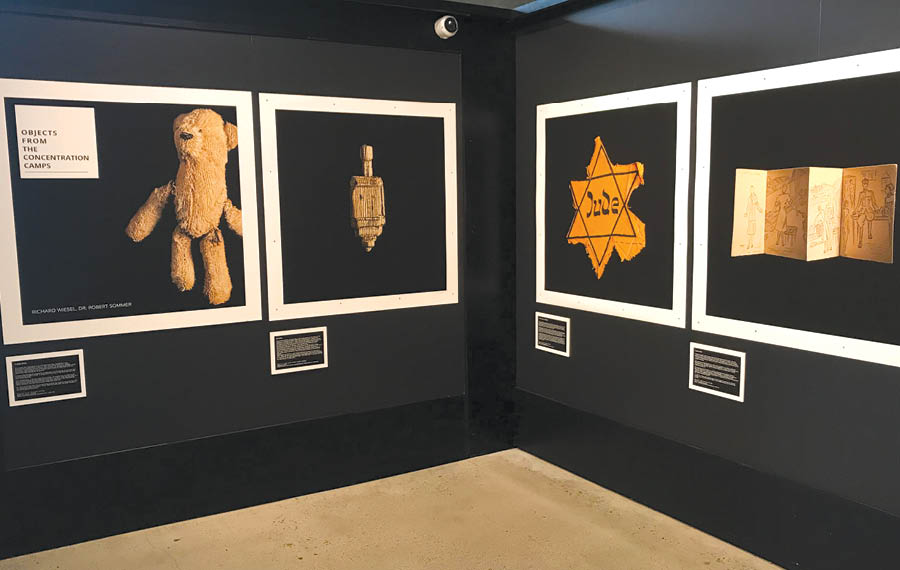 Photo courtesy of the Los Angeles Museum of the Holocaust
Photo courtesy of the Los Angeles Museum of the Holocaust A wooden dreidel that belonged to Hungarian Jews who perished at Auschwitz. A hollowed-out key used to pass secret messages between prisoners. A tiny Hebrew Tanakh passed on to a fellow prisoner before its owner was gassed.
Photographs of these and other artifacts — and the heartbreaking stories behind them — are on display in “Objects From the Concentration Camps” at the Los Angeles Museum of the Holocaust (LAMOTH).
Securing exclusive access to the archives of the Sachsenhausen and Ravensbruck concentration camps, Australian photo-grapher Richard Wiesel captured images of the objects and worked with historian Robert Sommer to research their provenance and owners’ fates.
LAMOTH Vice President of Education and Exhibits Jordanna Gessler told the Journal the impact of showing single objects allows visitors to think about the individuals who held, wore, or made them.
“It’s really difficult for any of us to imagine six million, but if you think about the human beings behind the objects it underlines the sadness and horrific impact [the Holocaust] had on humanity,” she said. “We’re giving people an opportunity to not just take in an object but consider and commemorate the person to whom it belonged and honor
their life.”
Choosing which of Wiesel’s many images to display, Gessler opted to concentrate on photographs depicting possessions of those who were enslaved, imprisoned and murdered, not those belonging to the perpetrators.
“The one Nazi artifact that we did leave in is a poison they used to stamp with [the pharmaceutical company] Bayer’s logo,” she said. “We wanted to stress that major corporations took part in the Holocaust, and encourage people to think about corporations that are taking part in atrocities today, such as dumping waste.”
Other artifacts include a handmade deck of playing cards, a child’s artificial leg, counterfeit currency, a bar of soap, a drawing depicting an SS doctor examining naked prisoners and the yellow Star of David that all Jews were made to wear.
“The images, I feel, are relatable for a wider audience,” Wiesel said in an email interview. “It’s about how we find strength through trauma and have hope when there is no hope or humanity around you. This project is not about left or right but about right and wrong.”
Of Romanian and Hungarian ancestry, the Sydney-born Wiesel, a first cousin once removed of Holocaust survivor and Nobel laureate Elie Wiesel, lost grandparents at Auschwitz and Bergen-Belsen. He grew up keeping kosher, attending Shabbat
services, had a bar mitzvah, celebrated the High Holy Days, and he remains connected to Judaism today. He visits family in
Israel often, supports the United Israel Appeal Women’s International Zionist Organization and belongs to an Orthodox synagogue in Sydney.
The project started with several trips he and Sommer made to the Ravensbruck and Sachsenhausen archives from June through September 2018. They narrowed down 120 artifacts to 30-40 from each camp, and researched each one using SS records.
Working with the objects “was supremely difficult but hugely rewarding,” he said. “I found myself going through the entire spectrum of emotion from anger to sadness to acceptance. But it was not hard to shake emotionally because we are telling the stories of these victims of the camps and in doing so, giving them a voice 75 years later.”
“We’re giving people an opportunity to not just take in an object but consider and commemorate the person to whom it belonged and honor their life”—Jordanna Gessler
Wiesel has been interested in photography since junior high school but set it aside to work in marketing for Universal Pictures and Paramount Pictures for 26 years until his wife suggested that he should “take it up with more vigor” in 2018. “I have been mentored by some amazing professional working photographers here in Sydney,” he said.
He’s currently working on a new project called “Living 9/11: An Exploration of Trauma and Resilience,” featuring images of first responders, survivors and family members of victims who died in the Twin Towers and on the downed planes.
Meanwhile, “Objects From the Concentration Camps,” has been exhibited in Berlin, Sydney, Johannesburg, Cape Town, Durban and most recently in Moscow, with more cities to come. A book compiling the images is in the works.
“We have a publisher and are looking to print in German and English,” Wiesel said. “If we don’t tell these stories, then who will? They will be forgotten to history. The lessons of tolerance and what it means to be human are needed today more than ever in a world of intolerance.”
“Objects From the Concentration Camps” is on view at the Los Angeles Museum of the Holocaust through April 10.




















 More news and opinions than at a Shabbat dinner, right in your inbox.
More news and opinions than at a Shabbat dinner, right in your inbox.